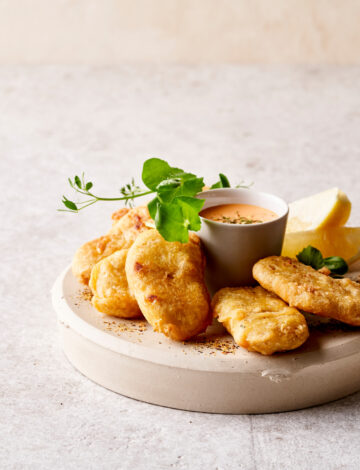The evolving landscape of coated foods
Health awareness has never been greater. Across markets, consumers are prioritizing nutrition without letting go of the comfort and convenience that coated foods deliver. Chicken nuggets, onion rings, and other breaded favorites remain popular, but today’s shoppers expect them to be lighter, more nutritious, and familiar in their ingredient choices.
This shift has made nutritional improvement a key priority for food manufacturers.
The dilemma: balancing indulgence and wellbeing
For many consumers, particularly Gen Z and young families, nutritional value now plays a decisive role in food choices. At the same time, the global coated foods market continues to grow, driven by the desire for convenience and sensory pleasure.
And the numbers confirm it:
- For France, 78% of the consumers say they choose foods they believe will positively impact their health, but at the same time, 43% of the consumers agree that taste is more important than health in their food choices.
- For the US, 84% of consumers prioritize nutrition when feeding their families, while 72% say taste remains a key driver in their food and drink choices.
(Source: Mintel, 2024)
This creates a learning opportunity for manufacturers:
- Prioritize nutritional value, and you risk losing the indulgent qualities consumers love.
- Focus purely on comfort and taste, and you risk alienating an increasingly health-conscious audience.
The challenge lies in achieving both pleasure and balance, delivering the flavour, texture, and appearance people expect while improving nutritional quality.
Food coatings: from crispy layer to nutritional opportunity
The opportunity for this balance lies in a part of the product that is often underestimated: the coating itself. The crispy layer can account for up to 30% (and even more) of a finished product’s weight, which makes it relevant to consider improving the nutrient density of the coated food product. Historically, coatings were designed to deliver four attributes: taste, color, texture, and visual appeal. But to meet modern expectations, they now need to support a fifth: nutritional performance. By rethinking coatings as vehicles for nutritional improvement, food manufacturers can reformulate classic comfort foods into balanced, better-for-you options.
Meeting expectations with next-generation nutritional coatings
At Solina, we’ve developed a new generation of nutritional coating systems that help manufacturers balance indulgence and nutrition. These innovations make it possible through reduced-fat formulations or fiber enrichment.
In Europe, this can support the development of products achieving Nutri-Score A or B or improving HFSS scores in the UK. In North America and beyond, it helps manufacturers meet better-for-you and clean-label expectations.
Two clear pathways toward healthier coated food
1. Fat-reduced coatings for better nutritional profiles
Reducing fat content is one of the most direct ways to improve the nutritional quality of coated foods. Our fat-reduced coating systems eliminate traditional frying steps, using hot air treatment during processing instead. Products can then be prepared in the oven or air fryer, maintaining convenience while significantly cutting fat.
Our premium batter and crumb solutions deliver:
- Fat content below 6% in the final product
- Improved nutritional ratings (Nutri-Score A/B in Europe or equivalent better-for-you claims elsewhere)
- Superior crunch and taste
- Bright, appealing color and consistent texture
In short, these coatings allow manufacturers to preserve indulgence while achieving measurable nutrition gains with only minor tweaks in the production process.
2. Fiber-enriched coatings for added benefits
Beyond reducing fat, nutritional coatings can enhance products through enrichment. Increasing fiber content is one of the most effective ways to add value.
Fiber has become an increasing focus for consumers, often referred to as “the new protein.” In the UK, 63% of the consumers agree that high-fiber foods keep you fuller for longer, a perception nearly as strong as protein (56%) (source: Mintel, 2025). The trend, known as “fibermaxxing,” reflects a growing desire for foods that offer both satisfaction and wellbeing.
Our fiber-enriched coating systems make it simple to deliver these benefits:
- Enable “source of fiber” or “high in fiber” claims
- Maintain full crunch, taste and visual appeal
- Integrate easily with existing coating lines and processes
- Fit both retail and foodservice formats
These coatings empower manufacturers to bring positive nutrition to coated foods without compromising on the sensory experience that defines them.
A balanced future for indulgent foods
Consumers want it all: great taste, better nutrition, and convenience. Manufacturers that deliver on these expectations, combining indulgence with nutritional integrity, will shape the future of coated foods.
At Solina, we support manufacturers with innovative coating solutions to design products that are better for consumers, better for brands, and better for business, naturally and without compromise.
A balanced future for indulgent foods
Consumers want it all: great taste, better nutrition, and convenience. Manufacturers that deliver on these expectations, combining indulgence with nutritional integrity, will shape the future of coated foods.
At Solina, we support manufacturers with innovative coating solutions to design products that are better for consumers, better for brands, and better for business, naturally and without compromise.

Know more?
Discover Solina’s coating solutions and learn how they can enhance both taste and nutrition in your next innovation.